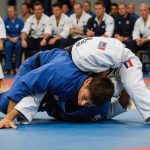Importance of Reaction Time in Badminton
In the fast-paced world of badminton, reaction time plays a pivotal role in determining a player’s success. At its core, reaction time is the interval between the perception of a stimulus and the initiation of a response. This brief window is crucial in badminton, where milliseconds can dictate the outcome of a match.
A player’s quick reflexes can markedly influence their decision-making process. As a shuttlecock hurtles across the net, players must rapidly assess its speed and trajectory, making split-second decisions on where to position themselves and how to respond. This instantaneous decision-making is what sets apart a seasoned player from a novice.
Have you seen this : Top Stretching Techniques to Safeguard Runners Against Shin Splints
Numerous studies highlight the correlation between enhanced reaction time and superior badminton performance. For instance, players with improved reflexes exhibit better defensive maneuvers, returning smashes with ease. Additionally, faster reaction times enable more efficient offensive plays, allowing players to anticipate and counter their opponent’s moves effectively.
Furthermore, practice routines often incorporate drills specifically designed to augment a player’s reaction time. These routines focus on fine-tuning the player’s ability to process visual and physical cues swiftly, with the ultimate goal of refining their on-court performance. By honing this critical skill, players significantly increase their chances of outmaneuvering their opponents and securing victory.
Also to read : Top Stretching Techniques to Safeguard Runners Against Shin Splints
Targeted Workouts to Boost Reaction Time
To enhance reaction time, incorporating targeted workouts is key. These include agility training, plyometric exercises, and strength and conditioning routines.
Plyometric Exercises
Plyometric exercises, known for improving explosive speed, focus on power and quickness. Common exercises include box jumps, squat jumps, and burpees. These exercises are beneficial because they train the muscles to exert maximum force in short intervals. Integrating routines such as 2-3 sets of 8 repetitions of box jumps into regular workouts can significantly enhance power output. However, safety is crucial. Ensure proper warm-up is performed to prevent injuries and start with lower heights to perfect technique.
Agility Drills
Agility drills specifically designed for badminton players help sharpen quick directional changes and balance. Cone drills and ladder drills effectively improve footwork speed and coordination. For example, setting up cones in a zigzag pattern and maneuvering through them swiftly hones agility skills. Including these drills in practice sessions twice per week is recommended for optimal results.
Strength and Conditioning
Strength training plays a significant role in boosting reaction time by building muscles used in fast movements. Exercises like lunges, deadlifts, and bench presses enhance core strength. A sample weekly plan can involve strength exercises for 45 minutes, followed by conditioning drills, performed on alternate days.
Drills to Enhance Speed and Quickness
Enhancing your speed and quickness is crucial for improving performance in many sports and activities. Focused training techniques can lead to significant advancements.
Reaction Time Drills
Improving reaction time is essential to boosting cognitive processing abilities in demanding situations. One effective drill involves partner exercises: have a partner randomly drop objects—such as tennis balls—and react as quickly as possible to catch them. This drill enhances real-time decision-making and offers immediate feedback. Aim to include reaction time drills in your routine, using video demonstrations to fine-tune movements, capturing nuances like balance and foot placement.
Shuttle Runs and Sprints
Incorporating shuttle runs and short sprints into your practice routine is beneficial. Shuttle runs enhance your ability to change direction quickly while maintaining speed. Set them up by marking equal distances, such as 5 or 10 metres, where athletes perform repeated bursts of speed, tapping each line and returning swiftly. Recommended frequency is 2-3 times a week, maintaining consistent timing during each sprint to track improvements. Both speed drills serve a dual purpose; they increase endurance and sharpen agility, critical for explosive movements required in diverse sports settings.
Nutrition Strategies for Optimal Performance
Understanding the critical role of nutrition can make all the difference in boosting your energy levels and enhancing your athletic performance. Nutrition serves as the foundation for success, providing necessary fuel to sustain activity and promote recovery.
For those engaging in sports like badminton, where agility and endurance are essential, knowing what to consume before and after workouts is vital. Pre-workout meals should focus on high carbohydrate content to maximize energy levels and provide a sustained release of energy. Consider options such as oatmeal with fruits or a smoothie enriched with bananas. Post-workout, it’s all about replenishment and repair. A balanced meal with lean protein, such as grilled chicken with quinoa, assists muscle recovery.
Hydration, often underestimated, directly affects reaction time and endurance. Dehydration can lead to fatigue and diminished performance. Regular intake of fluids, especially water, throughout the day is advised. For intense activity, incorporating an electrolyte solution may offer additional benefits in retaining essential minerals.
By implementing these nutrition strategies, athletes can optimise their performance and maintain consistent energy levels. With the correct nutrition, enhanced performance on the court becomes not only achievable but sustainable.
Recovery and Mental Focus Techniques
In badminton training, recovery is crucial for maintaining peak performance levels. Effective recovery practices include stretching, foam rolling, and incorporating regular rest days into your routine. These techniques help in reducing muscle soreness and preventing injuries, which is important for any athlete.
Equally, using tools such as fitness trackers can help monitor your recovery status by providing insights into your physiological state. This allows you to adjust your training programs as necessary, ensuring that you’re always at your best during competition.
Importance of Recovery
Recovery is not just about physical rest. It’s a complete approach that combines physical techniques with mental well-being. Using a foam roller can enhance blood flow and speed up muscle repair. On the other hand, rest days allow the body to regenerate and prepare for the next phase of training.
Mental Training Methods
Apart from physical recovery, mental strategies are vital in badminton to enhance concentration and focus. Techniques such as breathing exercises and mindfulness can significantly improve your mental clarity during matches.
Moreover, establishing a positive mental environment by setting realistic goals and maintaining a balanced lifestyle can vastly improve performance. Implementing these strategies not only boosts your mental health but also your playing ability.











